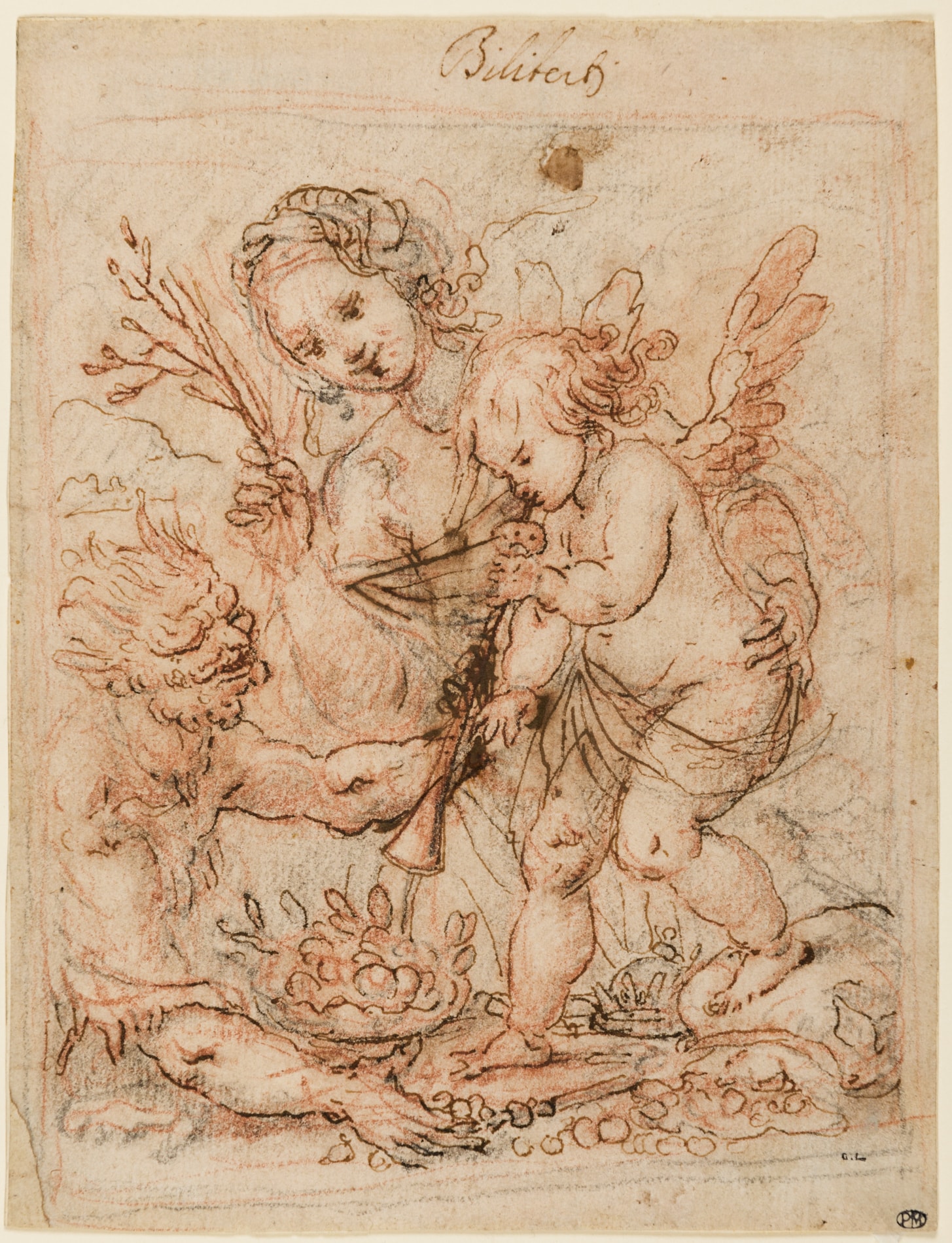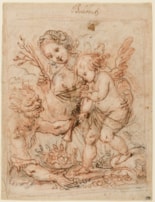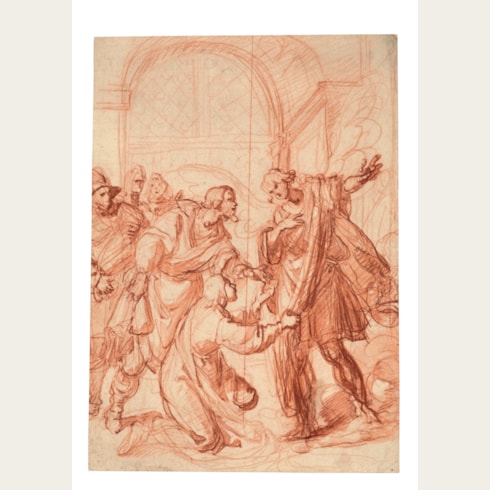Giovanni BILIVERT
(Florence 1585 - Florence 1644)
An Allegory with a Satyr, a Nymph and a Winged Putto Playing a Flute
Pen and brown ink, red and black chalk, with framing lines in both black and red chalk.
Inscribed Biliferti at the top.
165 x 126 mm. (6 1/2 x 5 in.)
Inscribed Biliferti at the top.
165 x 126 mm. (6 1/2 x 5 in.)
The present sheet depicts three figures – a woman holding a tree branch, a satyr, and a putto playing a flute - in a tightly compacted space. A similar arrangement of figures, although different in subject and composition, is found in a small painting on copper of Venus, Cupid and Pan by Giovanni Bilivert which appeared at auction in 2012 and 2018, of which a much larger autograph variant is today in the Gemäldegalerie in Dresden. A somewhat similar subject also occurs in a small painting of Sleeping Venus Enchained by Cupid with Pan, signed and dated 1638, which was recorded in a German private collection in 1929.
This drawing is likely to date to the first half of the 1630s, when Bilivert was engaged on a number of paintings of mythological subjects. Stylistically, the present sheet may be compared with a number of drawings in the Uffizi. These include a squared compositional study of Apollo and Daphne, which can be related to a painting dated 1630 in the Staatsgalerie in Stuttgart, and another squared drawing of Thetis Giving Arms to Achilles, which is a study for a painting of 1634 in a private collection. Other comparable drawings in the Uffizi include a red chalk study of a winged putto playing a violin and a drawing of Hercules Freeing Hesione, which is a first idea for a late painting by Bilivert, possibly executed with studio assistance, in an American private collection.
The first recorded owner of the present sheet was the New York physician George Ludwig Laporte (1874-1947), about whom very little is known, apart from the fact that his varied collection of drawings was sold, presumably by his heirs, at auction in 1968. Drawings from Laporte’s collection are today in the Metropolitan Museum of Art and the Pierpont Morgan Library in New York, the Art Institute of Chicago, and elsewhere.
This drawing was probably acquired at that time by the Hungarian-born journalist and passionate amateur of drawings Mathias Polakovits (1921-1987), who assembled a fine collection of Old Master drawings, mainly by French and Italian artists, over a period of about eighteen years. While the bulk of Polakovits’s collection of 17th and 18th century French drawings, numbering around three thousand sheets, was left to the Ecole des Beaux-Arts in Paris at his death, drawings by Italian artists and those of other schools were dispersed at auction in the late 1980s and beyond.
This drawing is likely to date to the first half of the 1630s, when Bilivert was engaged on a number of paintings of mythological subjects. Stylistically, the present sheet may be compared with a number of drawings in the Uffizi. These include a squared compositional study of Apollo and Daphne, which can be related to a painting dated 1630 in the Staatsgalerie in Stuttgart, and another squared drawing of Thetis Giving Arms to Achilles, which is a study for a painting of 1634 in a private collection. Other comparable drawings in the Uffizi include a red chalk study of a winged putto playing a violin and a drawing of Hercules Freeing Hesione, which is a first idea for a late painting by Bilivert, possibly executed with studio assistance, in an American private collection.
The first recorded owner of the present sheet was the New York physician George Ludwig Laporte (1874-1947), about whom very little is known, apart from the fact that his varied collection of drawings was sold, presumably by his heirs, at auction in 1968. Drawings from Laporte’s collection are today in the Metropolitan Museum of Art and the Pierpont Morgan Library in New York, the Art Institute of Chicago, and elsewhere.
This drawing was probably acquired at that time by the Hungarian-born journalist and passionate amateur of drawings Mathias Polakovits (1921-1987), who assembled a fine collection of Old Master drawings, mainly by French and Italian artists, over a period of about eighteen years. While the bulk of Polakovits’s collection of 17th and 18th century French drawings, numbering around three thousand sheets, was left to the Ecole des Beaux-Arts in Paris at his death, drawings by Italian artists and those of other schools were dispersed at auction in the late 1980s and beyond.
The son of a Dutch goldsmith and jeweller in the service of the Medici court, Giovanni Bilivert (sometimes Biliverti) trained with Alessandro Casolani in Siena before returning to Florence and joining the workshop of Ludovico Cigoli around 1590. He became one of Cigoli’s chief assistants, and remained in his studio for some fifteen years. Bilivert worked with Cigoli in Rome between 1604 and 1608, and upon his return to Florence entered the service of the Grand Duke Cosimo II de’ Medici, who in 1611 appointed him designer at the Opificio delle Pietre Dure, a salaried post he retained until Cosimo’s death in 1621. Bilivert’s independent career as a painter, which began in Rome with an altarpiece for the church of San Callisto, continued with much success in Florence. Most of his work was in the form of altarpieces and easel pictures, and he seems to have been uninterested in obtaining fresco commissions.
Among the artist’s important Florentine commissions were a painting for the cycle of scenes from the life of Michelangelo for the Casa Buonarotti, painted between 1616 and 1620, a Discovery of the True Cross completed in 1621 for the church of Santa Croce, and a Guardian Angel executed four years later for the Certosa at Galluzzo, just outside the city. Bilivert also worked in Pisa, where he completed an Annunciation and a San Carlo Borromeo in Adoration for the church of San Nicola in 1611, followed several years later by a painting of Daniel and Habbakuk for the Duomo, executed between 1625 and 1630. From around 1636 onwards he produced mainly religious pictures. Some Bilivert’s last works are a Mystic Marriage of Saint Catherine of Alexandria, painted in 1642 for the Florentine church of Santissima Annunziata, and a Miracle of Saint Paul, dated 1644, in San Marco. His pupils and followers included Orazio Fidani – who wrote a manuscript biography of the master - and Agostino Melissi, both of whom derived the composition of a number of their early paintings from drawings by Bilivert.
Somewhat less than four hundred drawings by Bilivert survive, of which the largest groups are today in the Uffizi in Florence, with almost three hundred sheets, and the Louvre in Paris, which houses some forty drawings by or attributed to the artist. Like his teacher Cigoli, Bilivert’s drawings were for him an important means of artistic expression. Most of his drawings can be directly related to his paintings, with the same compositions often studied repeatedly; as the 17th century Florentine biographer Filippo Baldinucci noted of Bilivert, ‘he always made a great number of studies for his works.’ However, he seems not to have made many drawings as autonomous works of art and, unusually for a Florentine artist of the period, produced no drawings of nudes, and almost no landscapes.
Among the artist’s important Florentine commissions were a painting for the cycle of scenes from the life of Michelangelo for the Casa Buonarotti, painted between 1616 and 1620, a Discovery of the True Cross completed in 1621 for the church of Santa Croce, and a Guardian Angel executed four years later for the Certosa at Galluzzo, just outside the city. Bilivert also worked in Pisa, where he completed an Annunciation and a San Carlo Borromeo in Adoration for the church of San Nicola in 1611, followed several years later by a painting of Daniel and Habbakuk for the Duomo, executed between 1625 and 1630. From around 1636 onwards he produced mainly religious pictures. Some Bilivert’s last works are a Mystic Marriage of Saint Catherine of Alexandria, painted in 1642 for the Florentine church of Santissima Annunziata, and a Miracle of Saint Paul, dated 1644, in San Marco. His pupils and followers included Orazio Fidani – who wrote a manuscript biography of the master - and Agostino Melissi, both of whom derived the composition of a number of their early paintings from drawings by Bilivert.
Somewhat less than four hundred drawings by Bilivert survive, of which the largest groups are today in the Uffizi in Florence, with almost three hundred sheets, and the Louvre in Paris, which houses some forty drawings by or attributed to the artist. Like his teacher Cigoli, Bilivert’s drawings were for him an important means of artistic expression. Most of his drawings can be directly related to his paintings, with the same compositions often studied repeatedly; as the 17th century Florentine biographer Filippo Baldinucci noted of Bilivert, ‘he always made a great number of studies for his works.’ However, he seems not to have made many drawings as autonomous works of art and, unusually for a Florentine artist of the period, produced no drawings of nudes, and almost no landscapes.
Provenance
Dr. George L. Laporte, New York (Lugt 1170)
His posthumous sale (Master Drawings from 16th to 19th Centuries, all from the Estate of a New York Private Collector), New York, O’Reilly’s Plaza Art Galleries, 25 April 1968, probably part of lot 101 (Giovanni Biliverti, Giovanni Barbieri, Two Drawings of various sizes)
Paul Mathias Polakovits, Paris (Lugt 3561)
Anonymous sale, London, Sotheby’s, 2 July 1997, lot 7
Margot Gordon, New York, in 1998
Private collection.
His posthumous sale (Master Drawings from 16th to 19th Centuries, all from the Estate of a New York Private Collector), New York, O’Reilly’s Plaza Art Galleries, 25 April 1968, probably part of lot 101 (Giovanni Biliverti, Giovanni Barbieri, Two Drawings of various sizes)
Paul Mathias Polakovits, Paris (Lugt 3561)
Anonymous sale, London, Sotheby’s, 2 July 1997, lot 7
Margot Gordon, New York, in 1998
Private collection.







